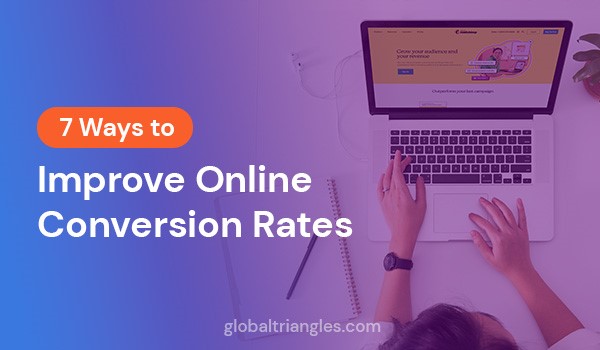Business
E-commerce Insights with Global Triangles: How to Improve Online Conversion Rates

Online shopping experiences continue to attract consumers thanks to their convenience. Several factors drive this trend, including growing smartphone ownership, improved logistics, more secure payment methods, and consumer trends.
However, as online shopping increases, so does the competition. Additionally, shoppers want better choices, reasonable prices, convenience, and brands aligning with their values. Improving conversion requires a data-driven approach that allows companies to implement strategic changes to enhance user trust through better customer relationship management and optimized user experiences.
Garry Lea, CEO of Global Triangles, an e-commerce development company, says, “The e-commerce space continues to face many challenges, including logistics, distributions, warehouse management, and payment safety.” He continues, “However, conversions continue to be one of their most problematic because of increasing competition and unoptimized consumer interactions.”
How to Improve Online Conversion Rates
Businesses can lower their cost of acquisition by increasing their conversion rates on their website or landing pages in several ways, including the seven below:
1. Perform A/B testing
Providing value for your online customers is vital, but you cannot offer value without the necessary data. Besides storing and analyzing that data, you can use it to perform A/B testing or display campaign variations to see which will appeal more to customers and lead to more conversions.
You can test several elements with A/B testing, including the effectiveness of headlines and your copy, layout, colors, and CTAs.
2. Provide Social Proof
Most consumers don’t purchase until they have checked online reviews in keeping with the psychological phenomenon of social proof. A study commissioned by Trustpilot found that 49% of consumers say positive reviews are one of their top three purchase influences.
Therefore, you cannot omit to provide social proof on your website if you want better conversion rates. You can link to other directory pages where users leave reviews. However, that’s not enough. Ensure your prospects don’t need to leave your website by adding reviews and testimonials.
3. Optimize CTAs
Whether your call to action (CTA) is for your user to subscribe to your newsletter or to purchase an offer, it plays a massive role in your conversions.
To ensure they attract attention, provide clear and visible CTAs in as many places as possible on your landing page and website. You can include it more than once, so the user doesn’t need to scroll down to the bottom to see it.
Therefore, you want a CTA to appear as soon as possible and often enough without creating a spammy approach that will deter your website visitor. Your message communication also plays a vital role in prompting the user to take action.
4. Increase User Trust
It is more difficult to develop trust with consumers online than offline. Unfortunately, “experience friction” can also decrease trust levels, leading to minimal conversions.
A great product, transparency, strong customer relationships, and showing your company values are some ways to increase consumer trust. Others include money-back guarantees and avoiding using spam links. However, UX also plays a vital role here, so make your site easy to navigate and update its content.
Consumers are wary and distrustful of sites that have broken links or haven’t posted in a while, leading to friction and distrust. Therefore, remove these issues. You can also add team bios to introduce your team to your users, increasing their trust.
5. Clearly State Your Value Proposition
Average conversion rates continue to increase but remain between 2 and 5% in most industries. A value proposition on your landing page articulates why your product is better than others. Understanding your buyer persona is the best way to communicate your value proposition.
Remember, your value proposition is not a tagline but an opportunity to communicate the benefits of your product or service with your target audience by addressing their pain points, goals, or motivations.
Discussing the product’s benefits is more important than the features because they can convert customers who want to add these benefits to their life. Therefore, if your landing pages aren’t converting satisfactorily, review and rewrite your value proposition if necessary.
6. Convince Shoppers with Abandoned Cart Campaigns
Visitors will often add something to their cart without continuing to check out. These abandoned carts represent potential customers that you cannot afford to ignore. Abandoned cart email campaigns will remind them that they were looking at specific products, and you can use a discount offer to entice them back.
7. Improved Page Speed
More than ever, consumer spending on e-commerce is increasing from mobile devices. Grow your mobile conversion rate by improving your page speed since most people abandon a site if it needs longer than three seconds to load.
You can optimize your site for mobile by putting it through Google’s mobile testing tool and following its recommendations. However, you can also increase its speed by making its images smaller and compressing them.
Final Take
Implement these measures to ensure higher conversions on your website and its landing pages. As you can see, the saying “the customer always comes first” applies as much with e-commerce as ever before. Put yourself in your consumer’s shoes, and provide them with the best UX. You will see the difference in your online conversion rates.
-

 Destinations4 days ago
Destinations4 days agoSave Money in London: Insider Tips for Budget Travellers
-

 USA News3 days ago
USA News3 days agoWhat Is The Current Us Elections Rating And Who Is Leading The Polls?
-

 Technology5 days ago
Technology5 days agoEnhancing Lead Management and Text Marketing with Launch Control’s All-in-One CRM
-

 Europe News3 days ago
Europe News3 days agoSee Rome on a Budget: History and Culture Without the Cost
-

 Travel3 days ago
Travel3 days agoHow to Make Friends in Southeast Asia Hostels: A Guide for Solo Travellers
-

 Climate Change3 days ago
Climate Change3 days agoCuba Faces Nationwide Power Grid Collapse Amidst Ongoing Crisis
-

 Travel3 days ago
Travel3 days agoSafe Travel in Mexico: Tips for a Hassle-Free Trip
-

 Destinations4 days ago
Destinations4 days agoArgentina Travel Guide: Tango, Wine, and Natural Wonders












